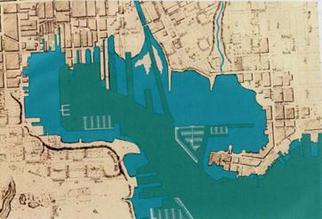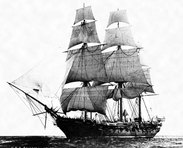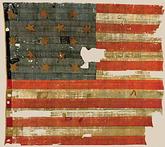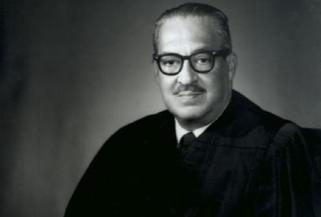|
Baltimore: Home of Duck Pin Bowling
Some Planning
Department staff members, who were born and raised in other cities, had never
been duck pin bowling. So the Planning
Department hosted a team building event at Patterson Bowling Center on Eastern
Avenue to share this special Baltimore tradition.
 Although the true origin of duck pin bowling is the subject of some dispute, according to our sources at Wikipedia, two Hall of Fame Baltimore Orioles, John McGraw and Wilbert Robinson claim to have created the game at the turn of the 20th century, at a bowling, billiards and pool hall they both owned in Baltimore. Regardless of the true origin of the game, it has been a Baltimore tradition ever since. (Source: Wikipedia)
Another
fun fact, the Patterson Bowling Center opened in 1927, has 12 lanes and is the oldest operating duck pin bowling
alley in the country.
|
Celebrating
the Ongoing Transformation of the Baltimore Harbor
Although it didn’t truly take over 100 years to
turn Baltimore’s Inner Harbor from its storied industrial past into a shining
example of urban waterfront revitalization, sometimes it might have seemed that
way. In a news article printed in August
1898 by the Kent News of Chestertown, Maryland,
Baltimore’s harbor was described in unpleasant detail:
"Every visitor to Baltimore is astonished that
the foulness of the harbor if that great city is allowed to continue. Its
offensiveness, its unsightliness, its menace to health--all reflect upon the
city authorities."
 Above: A view of Downtown from the Middle Branch.
 While the northwest branch of the Patapsco River did experience
hundreds of years of use as an industrial port, thanks to the genius of civic
leaders like former Governor William Donald Schaeffer and James W. Rouse,
master city planner, Baltimore's "Inner Harbor" was transformed
with the completion of the promenade in 1973, and the opening of Harborplace in
1980.
But did you know that the Inner Harbor is now much smaller than it
used to be? The natural
harbor was broad, with marshes at the confluence of the Jones Falls and
Northwest Branch of the Patapsco River. Water Street, which is now
located between Lombard and Redwood Streets, was so named because it used to be
close to the water. Over many years, the harbor has been filled and bulk-headed,
resulting in a much smaller, narrower urban harbor. The image below shows an early map of the
harbor, and an overlay of its existing configuration. A similar image is featured in Inner Harbor
2.0 a new master plan for Baltimore’s Inner Harbor.
|
 The Planning Department looks forward to continuing our role in
creating a world class urban waterfront by helping shape the next 100 years of
the Baltimore Harbor with the impending completion of Inner Harbor 2.0
(Sources: CharmCityHistory.com,
and the Baltimore
Ecosystem Study).
Baltimore: A City
of Firsts
Before it came to be known as Charm City, Baltimore was also known
as A City of Firsts. Baltimore is home to a wide variety of U.S.
and world first inventions, activities and civic organizations. While there are many Baltimore “Firsts” the
fact that 2014 is the 200th anniversary of the Star Spangled Banner
and the Battle of Baltimore, and this month is African American
History Month, we’re focusing on those Baltimore
Firsts that highlight these important celebrations.
Star Spangled Firsts
In 1797 the original
Constellation became the first US war ship to capture an enemy vessel. Currently the crown jewel in Baltimore’s
collection of historic ships, the second incarnation of the U.S.S.
Constellation, built in 1854, will welcome a visiting fleet of tall ships into
the harbor in September, 2014 for the Star Spangled Sailabration.

The Constellation was also on hand to
celebrate the one-hundredth anniversary of the writing of the national anthem,
after being invited by the National Star Spangled Banner Centennial commission to
participate. Then Acting Secretary of the Navy Franklin D. Roosevelt ordered
the vessel restored "as she appeared in 1814," but to minimize costs,
"include only such general details as would be noticed by the
layman." After restoration in
Norfolk, the Constellation was towed to Baltimore Harbor, where she
stayed on display from September 7th (the anniversary of the 1797
frigate's launching) until October 29, 1914. She was then towed to Washington,
DC where she was displayed until December.
After additional repairs at Norfolk in December, the Constellation was
returned to training duty in Newport on May 19th, 1915. She has been
on permanent display in the Baltimore Inner Harbor since July 2, 1999. (Source:
Historicships.org)
|
 Above: Aerial Photo of Modern Day Fort McHenry. Below: Image of the original Star Spangled Banner when on display at the Smithsonian.

In the 1790’s the newly formed U.S. Government commissioned a series of coastal
military forts, the first of which was completed in Baltimore -- Fort McHenry. The history of Fort McHenry, however, began in 1776 when the citizens of Baltimore Town feared
an attack by British ships. In response, an earthen star fort known as Fort
Whetstone was constructed. This fort, like Baltimore, was never attacked during
the war for independence. Then in 1793, the Napoleonic Wars began when France
declared a war with England.
In
1794, Congress authorized the construction of a series of coastal forts to
protect our maritime interests. Construction began on Fort McHenry, at the site
of Fort Whetstone, in 1798 and by 1803 the masonry walls we view today were
completed. The fort was named for James McHenry, our second Secretary of
War. In 1809, the U.S. Army organized its first light artillery unit at Fort McHenry.
As we know, Fort McHenry played a pivotal role in the War of 1812, when during the 1814 Battle of
Baltimore, Francis Scott Key witnessed the bombardment of Fort McHenry and
penned a poem called the Defiance of Fort McHenry from a ship in the
Baltimore Harbor. The poem was
subsequently set to the tune of a popular British song and renamed The Star
Spangled Banner.
The Star-Spangled Banner was first recognized for official
use by the Navy in 1889, and by President Woodrow Wilson in 1916. It wasn’t made the official national anthem
until 1931 when a congressional resolution was signed into law by President Herbert Hoover. (Source: National Park Service – Fort McHenry)
|
Firsts in African American History
African Americans have played an
important role in U.S. history since colonial times. In turn, Baltimore has played an important
role in that same history. Below are
just a few examples of Baltimore’s Historic Firsts that should be celebrated as
part of American history, especially during February, in honor of African
American History Month.
-
1817 - The
African Methodist Episcopal church held its first conference in Baltimore.
-
1829 - The Oblate
Sisters of Providence formed the first Catholic order for black nuns.

1866 – Isaac Myers partnered with other Black leaders in Baltimore to form the
first black-owned shipyard, the Chesapeake Marine Railway and Dry Dock Company,
at what is now the Frederick Douglass-Isaac Myers Maritime Park.
|
-
1869 – Isaac
Myers organized the nation’s first black labor union – the Colored National
Labor Union.
-
1921 – “Shuffle Along” becomes the
first black musical on Broadway, it was written by Baltimore’s own Eubie Blake.
-
1936 – Baltimore’s
Afro-American Newspaper, originally founded in 1892 by former slave, John H. Murphy, Sr., becomes the
nation’s first black newspaper chain. There have been as many as 13 editions of
the newspaper in major cities across the country; today there are just two: one
in Baltimore, and the other in Washington, D.C.[3]

-
1967 – Baltimore’s own Thurgood Marshall was appointed the first
African-American to serve on the US Supreme Court. Marshall was born in Baltimore, Maryland, on July 2, 1908. He was the great-grandson
of a slave who was born in the modern-day Democratic
Republic of the Congo;[2][3] his grandfather was also a slave.[4] His father, William Marshall, a railroad
porter, and his mother Norma, a teacher, instilled in him an appreciation for
the United States Constitution and the rule of law.[5] Marshall attended Frederick
Douglass High School.
-
1983 – The
National Great Blacks in Wax Museum became the first African American wax
museum.
|